Amazing Sea Butterflies Are the Ocean’s Canary in the Coal Mine
These delicate and stunning creatures are offering Smithsonian scientists a warning sign for the world’s waters turning more acidic
/https://tf-cmsv2-smithsonianmag-media.s3.amazonaws.com/filer/e5/6c/e56c67c3-68c0-43de-90d0-407e3adf1a98/bugle-shell-pteropod-611.jpg)
The chemistry of the ocean is changing. Most climate change discussion focuses on the warmth of the air, but around one-quarter of the carbon dioxide we release into the atmosphere dissolves into the ocean. Dissolved carbon dioxide makes seawater more acidic—a process called ocean acidification—and its effects have already been observed: the shells of sea butterflies, also known as pteropods, have begun dissolving in the Antarctic.
Tiny sea butterflies are related to snails, but use their muscular foot to swim in the water instead of creep along a surface. Many species have thin, hard shells made of calcium carbonate that are especially sensitive to changes in the ocean’s acidity. Their sensitivity and cosmopolitan nature make them an alluring study group for scientists who want to better understand how acidification will affect ocean organisms. But some pteropod species are proving to do just fine in more acidic water, while others have shells that dissolve quickly. So why do some species perish while others thrive?
It’s a hard question to answer when scientists can hardly tell pteropod species apart in the first place. The cone-shaped pteropod shown here is in a group of shelled sea butterflies called thecosomes, from the Greek for “encased body.” There are two other groups: the pseudothecosomes have gelatinous shells, and the gymnosomes (“naked body”) have none at all. Within these groups it can be hard to tell who’s who, especially when relying on looks alone. Scientists at the Smithsonian’s National Museum of Natural History are using genetics to uncover the differences among the species.
This effort is led by zoologist Karen Osborn, who has a real knack for photography: in college, she struggled over whether to major in art or science. After collecting living animals while SCUBA diving in the open ocean, she brings them back to the research ship and photographs each in a shallow tank of clear water with a Canon 5D camera with a 65mm lens, using three to four flashes to capture the colors of the mostly-transparent critters. The photographs have scientific use—to capture never-before-recorded images of the living animals—and to “inspire interest in these weird, wild animals,” she said. All of these photos were taken in the Pacific Ocean off the coasts of Mexico and California.
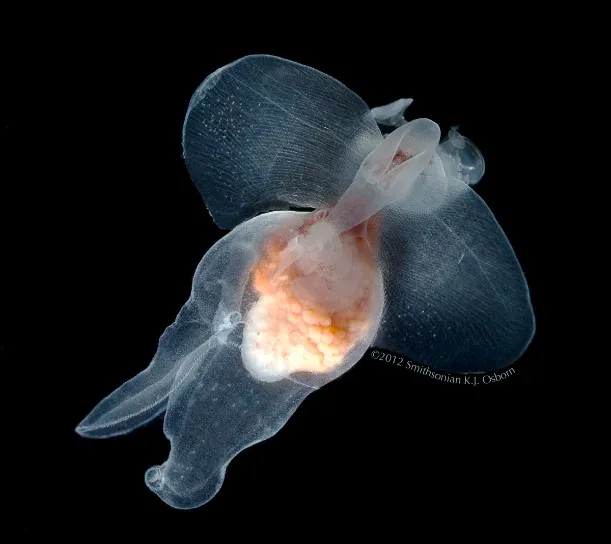
Although sea butterflies in the gymnosome group, like the one seen above, don’t have shells and are therefore not susceptible to the dangers of ocean acidification, their entire diet consists of shelled pteropods. If atmospheric CO2 continues to rise due to the burning of fossil fuels and, in turn, the ocean becomes more acidic, their prey source may disappear—indirectly endangering these stunning predators and all the fish, squid and other animals that feed on the gymnosomes.
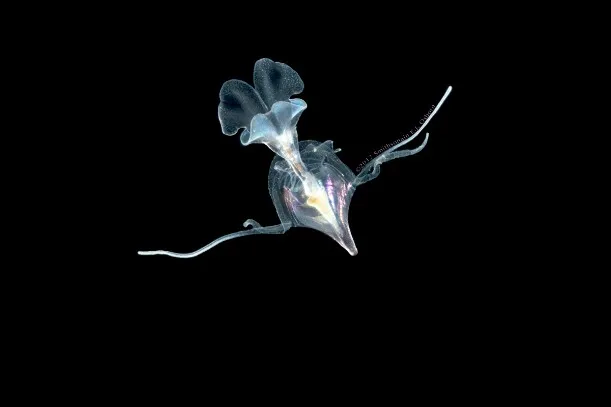
For years, sea butterflies were only collected by net. When collected this way, the animals (such as Cavolinia uncinata above) retract their fleshy “wings” and bodies into pencil eraser-sized shells, which often break in the process. Researchers then drop the collected pteropods into small jars of alcohol for preservation, which causes the soft parts to shrivel—leaving behind just the shell. Scientists try to sort the sea butterflies into species by comparing the shells alone, but without being able to see the whole animals, they may miss the full diversity of pteropods.
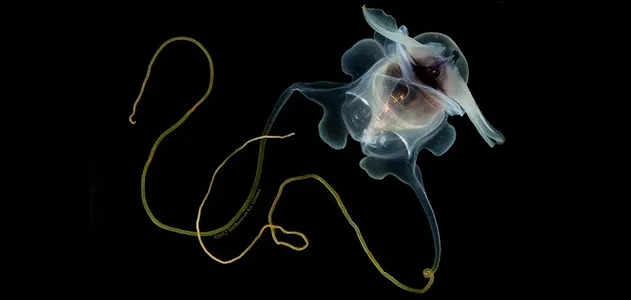
More recently, scientists such as Osborn and Smithsonian researcher Stephanie Bush have begun collecting specimens by hand while SCUBA diving in the open sea. This blue-water diving allows her to collect and photograph fragile organisms. As she and her colleagues observe living organisms in more detail, they are realizing that animals they had thought were the same species, in fact, may not be! This shelled pteropod (Cavolinia uncinata) is considered the same species as the one in the previous photo. Because their fleshy parts look so different, however, Bush is analyzing each specimen’s genetic code to establish whether they really are the same species.
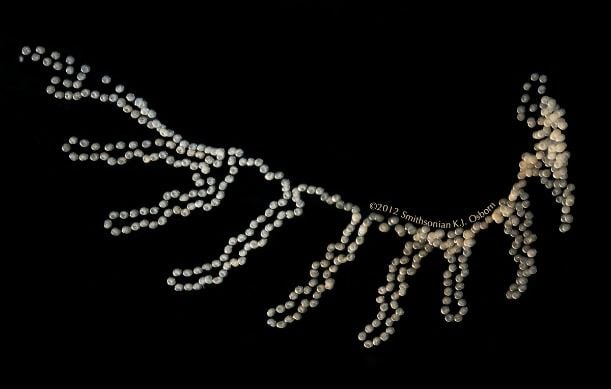
This string of eggs shot out of Cavolinia uncinata when it was being observed under the microscope. The eggs are attached to one another in a gelatinous mass, and, had they not been self-contained in a petri dish, would have floated through the water until the new pteropods emerged as larvae. Their reproduction methods aren’t well studied, but we know that pteropods start off as males and once they reach a certain size switch over to females. This sexual system, known as sequential hermaphroditism, may boost reproduction because bigger females can produce more eggs.
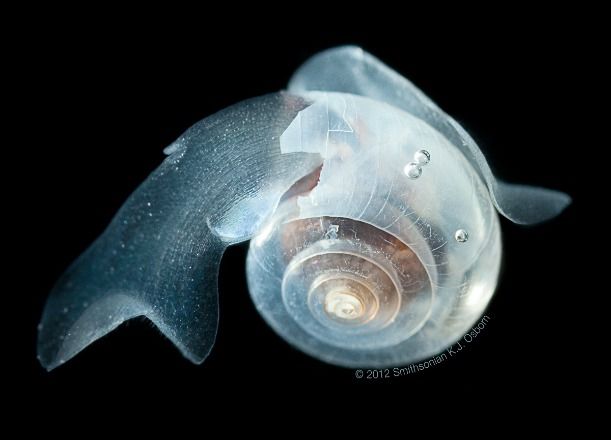
This pteropod (Limacina helicina) has taken a beating from being pulled through a trawl net: you can see the broken edges of its shell. An abundant species with black flesh, each of these sea butterflies are the size of a large grain of sand. In certain conditions they “bloom” and, when fish eat too many, the pteropod’s black coloring stains the fishes’ guts black.
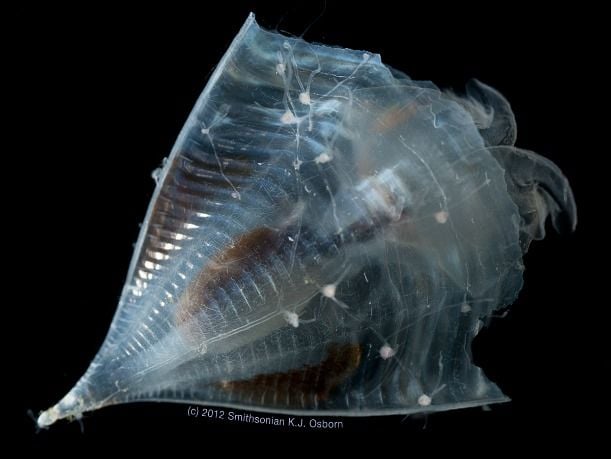
Not only is the inside of this shell home to a pteropod (Clio recurva), but the outside houses a colony of hydroids—the small pink flower-like animals connected by transparent tubing all over the shell. Hydroids, small, predatory animals related to jellyfish, need to attach to a surface in the middle of the ocean to build their colony, and the tiny shell of Clio is the perfect landing site. While it’s a nice habitat for the hydroids, this shell probably provides less than ideal protection for the pteropod: the opening is so large that a well equipped predator, such as larger shell-less pteropods, can likely just reach in and pull it out. “I would want a better house, personally,“ says Osborn.
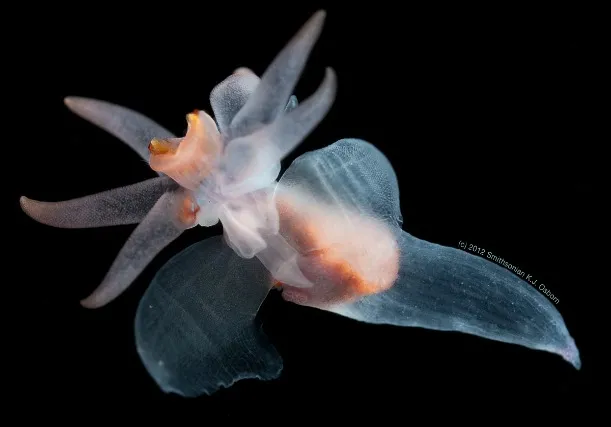
Gymnosomes are pteropods that lack shells and have a diet almost entirely composed of shelled pteropods. This species (Clione limacina), exclusively feeds on Limacina helicina (the black-fleshed pteropod a few slides back). They grab their shelled relative with six tentacle-like arms, and then use grasping jaws to suck their meal out of the shell.
 This post was written by Emily Frost and Hannah Waters. Learn more about the ocean from the Smithsonian’s Ocean Portal.
This post was written by Emily Frost and Hannah Waters. Learn more about the ocean from the Smithsonian’s Ocean Portal.